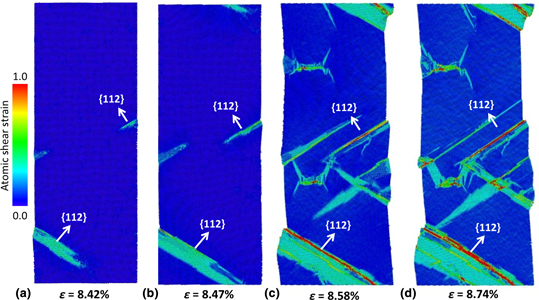Crossref Citations
This article has been cited by the following publications. This list is generated based on data provided by
Crossref.
Chen, Haotian
Fang, Qihong
Zhou, Kun
Liu, Yong
and
Li, Jia
2020.
Unraveling atomic-scale crystallization and microstructural evolution of a selective laser melted FeCrNi medium-entropy alloy.
CrystEngComm,
Vol. 22,
Issue. 24,
p.
4136.
Peng, Jing
Li, Fang
Liu, Bin
Liu, Yong
Fang, Qihong
Li, Jia
and
Liaw, Peter K.
2020.
Mechanical properties and deformation behavior of a refractory multiprincipal element alloy under cycle loading.
Journal of Micromechanics and Molecular Physics,
Vol. 05,
Issue. 04,
p.
2050014.
Li, Jia
Chen, Haotian
He, Quanfeng
Fang, Qihong
Liu, Bin
Jiang, Chao
Liu, Yong
Yang, Yong
and
Liaw, Peter K.
2020.
Unveiling the atomic-scale origins of high damage tolerance of single-crystal high entropy alloys.
Physical Review Materials,
Vol. 4,
Issue. 10,
Chen, Shuai
Aitken, Zachary H.
Wu, Zhaoxuan
Yu, Zhigen
Banerjee, Rajarshi
and
Zhang, Yong-Wei
2020.
Hall-Petch and inverse Hall-Petch relations in high-entropy CoNiFeAlxCu1-x alloys.
Materials Science and Engineering: A,
Vol. 773,
Issue. ,
p.
138873.
Giwa, Adenike M.
Aitken, Zachary H.
Liaw, Peter K.
Zhang, Yong-Wei
and
Greer, Julia R.
2020.
Effect of temperature on small-scale deformation of individual face-centered-cubic and body-centered-cubic phases of an Al0.7CoCrFeNi high-entropy alloy.
Materials & Design,
Vol. 191,
Issue. ,
p.
108611.
Li, Jia
Fang, Qihong
and
Liaw, Peter K.
2021.
Microstructures and Properties of High‐Entropy Materials: Modeling, Simulation, and Experiments.
Advanced Engineering Materials,
Vol. 23,
Issue. 1,
Peng, Jing
Li, Li
Li, Fang
Liu, Bin
Zherebtsov, Sergey
Fang, Qihong
Li, Jia
Stepanov, Nikita
Liu, Yong
Liu, Feng
and
Liaw, Peter K
2021.
The predicted rate-dependent deformation behaviour and multistage strain hardening in a model heterostructured body-centered cubic high entropy alloy.
International Journal of Plasticity,
Vol. 145,
Issue. ,
p.
103073.
Hazan, A.
Hillel, G.
Kalabukhov, S.
Frage, N.
Zaretsky, E.B.
and
Meshi, L.
2021.
Shock-induced twinning in polycrystalline vanadium: II. Surface layer.
Materials Characterization,
Vol. 175,
Issue. ,
p.
111062.
Wu, Yuan
Zhang, Fei
Yuan, Xiaoyuan
Huang, Hailong
Wen, Xiaocan
Wang, Yihan
Zhang, Mengyuan
Wu, Honghui
Liu, Xiongjun
Wang, Hui
Jiang, Suihe
and
Lu, Zhaoping
2021.
Short-range ordering and its effects on mechanical properties of high-entropy alloys.
Journal of Materials Science & Technology,
Vol. 62,
Issue. ,
p.
214.
Xu, Shuozhi
Jian, Wu-Rong
and
Beyerlein, Irene J.
2022.
Ideal simple shear strengths of two HfNbTaTi-based quinary refractory multi-principal element alloys.
APL Materials,
Vol. 10,
Issue. 11,
Sher, Amit
Meshi, Louisa
Kalabukhov, Sergei
Frage, Nachum
and
Zaretsky, Eugene B.
2022.
Shock wave determination of temperature dependence of twinning stress in vanadium and tantalum.
Materials Science and Engineering: A,
Vol. 833,
Issue. ,
p.
142537.
Xu, Qin
Wang, Qi
Chen, De-zhi
Fu, Yi-ang
Shi, Qing-sheng
Yin, Ya-jun
and
Zhang, Shu-yan
2022.
Microstructure characteristics and mechanical properties of NbMoTiVWSix refractory high-entropy alloys.
China Foundry,
Vol. 19,
Issue. 6,
p.
495.
Xu, Shuozhi
Al Mamun, Abdullah
Mu, Sai
and
Su, Yanqing
2023.
Uniaxial deformation of nanowires in 16 refractory multi-principal element alloys.
Journal of Alloys and Compounds,
Vol. 959,
Issue. ,
p.
170556.
Li, Xiyao
Zhang, Ze
and
Wang, Jiangwei
2023.
Deformation twinning in body-centered cubic metals and alloys.
Progress in Materials Science,
Vol. 139,
Issue. ,
p.
101160.
Deluigi, Orlando
Valencia, Felipe
Tramontina, Diego R.
Amigo, Nicolás
Rojas-Nunez, Javier
and
Bringa, Eduardo M.
2023.
Influence of Grain Size on Mechanical Properties of a Refractory High Entropy Alloy under Uniaxial Tension.
Crystals,
Vol. 13,
Issue. 2,
p.
357.
Babicheva, Rita I.
Semenov, Aleksander S.
Izosimov, Artem A.
and
Korznikova, Elena A.
2024.
Analysis of Short-Range Ordering Effect on Tensile Deformation Behavior of Equiatomic High-Entropy Alloys TiNbZrV, TiNbZrTa and TiNbZrHf Based on Atomistic Simulations.
Modelling,
Vol. 5,
Issue. 4,
p.
1853.
Cantor, Brian
2024.
Fundamentals of Multicomponent High-Entropy Materials.
p.
223.
Faisal, Anik H.M.
and
Weinberger, Christopher R.
2024.
The structure of deformation twins in BCC transition metals during nucleation and growth.
Computational Materials Science,
Vol. 233,
Issue. ,
p.
112749.
Nitol, Mashroor S.
Echeverria, Marco J.
Dang, Khanh
Baskes, Michael I.
and
Fensin, Saryu J.
2024.
New modified embedded-atom method interatomic potential to understand deformation behavior in VNbTaTiZr refractory high entropy alloy.
Computational Materials Science,
Vol. 237,
Issue. ,
p.
112886.
Pan, Yang
Fu, Tao
Duan, Mengye
Li, Chuanying
Hu, Hao
and
Peng, Xianghe
2024.
Tension–Compression Asymmetry of BCC NbMoTaW in High Entropy Alloy Nanowires.
ACS Applied Nano Materials,
Vol. 7,
Issue. 7,
p.
8121.


